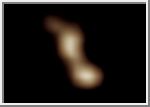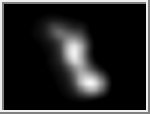













|
(Adapted from NASA Press Release 99-88)
Asteroid Braille (1992 KD) was discovered on May 27, 1992 by astronomers Eleanor Helin and Kenneth Lawrence using the 46 centimeter (18 inch) Shmidt telescope at Palomar Observatory, while scanning the skies as part of the Palomar Planet-Crossing Asteroid Survey. Braille became the target of NASA's Deep Space 1 spacecraft on July 29, 1999 when the spacecraft flew within an estimated 26 kilometers (16 miles) of the asteroid. The spacecraft's infrared sensor confirmed that the small asteroid is similar to Vesta, a rare type of asteroid and one of the largest bodies in the main asteroid belt, which lies between Mars and Jupiter.
"This clear link between Vesta and Braille is an important finding," said Dr. Laurence Soderblom of the U.S. Geological Survey, team leader for Deep Space 1 experiments using the spacecraft's integrated spectrometer and imaging instrument. Scientists are now wrestling with a thorny question: Is the near-Earth asteroid Braille a chip off Vesta's old block, or are the two asteroids siblings which originated elsewhere, perhaps thrown off a larger body that has long since been destroyed?
The scientists made their finding from three sets of data collected by the spacecraft's infrared camera. Called spectra (data obtained when the instrument breaks light into component colors, much like a prism does) the data sets cover different parts of the asteroid and were taken just after closest approach.
Braille's longest side is now estimated at 1.3 miles (2.2 kilometers) and its shortest side appears to be 0.6 miles (1 kilometer). This elongated asteroid was expected to be irregular, and two photographs taken approximately 15 minutes after closest encounter have helped to confirm this.
By contrast, Vesta, discovered in 1807, has a diameter of about 310 miles (500 kilometers). The fourth asteroid ever discovered, Vesta shares with Braille a high visual reflectivity. In fact, Vesta is the most reflective of the main-belt asteroids.
Apart from flyby findings, project scientists have determined that in about 4,000 years Braille will join the hundreds of other asteroids that drift in and out of Earth's orbit.
The flyby, at 12:46 am EDT on July 29, occurred at an estimated distance of 16 miles (26 kilometers), although the exact distance is still being measured. Diagnosis of an apparent target- tracking problem that affected the taking of black-and-white photos during the flyby continues.
Launched Oct. 24, 1998, Deep Space 1 is the first mission under NASA's New Millennium Program, which tests new technologies for future space and Earth-observing missions. The technologies that have been tested on Deep Space 1 will help make future science spacecraft smaller, less expensive and capable of more independent decision-making so that they rely less on tracking and intervention by ground controllers.
Of the 12 new technologies on board, all but the spacecraft's autonomous navigation system had been completely tested since launch. With the asteroid encounter, AutoNav successfully finished its last 5 percent of testing. Science return was a bonus for this technology validation mission.
| Images of Braille |
|---|
 Enhanced Color Image of Asteroid Braille from Deep Space 1
Enhanced Color Image of Asteroid Braille from Deep Space 1
This image was created from a composite of two images which
were taken by Deep Space 1 of asteroid 9969 Braille.
The final image was enhanced and overlayed with a reddish hue,
based upon descriptions of the asteroid.
(Courtesy Ted Stryk, NASA)
 Composite View of Asteroid Braille from Deep Space 1
Composite View of Asteroid Braille from Deep Space 1
The two images on the left hand side of this composite image frame were
taken 914 seconds and 932 seconds after the recent Deep Space 1
(DS1) encounter with the asteroid 9969 Braille by the Miniature
Integrated Camera Spectrometer (MICAS). The image on the right was created
by combining the two images on the left. The Sun is illuminating
Braille from below , as is indicated by the arrow.
Braille (also known as 1992 KD) was discovered on May 27, 1992 by
astronomers Eleanor Helin and Kenneth Lawrence using the 46
centimeter (18 inch) Shmidt telescope at Palomar Observatory, while
scanning the skies as part of the Palomar Planet-Crossing Asteroid Survey.
(Courtesy USGS)
 Enhanced Image of Asteroid Braille from Deep Space 1
Enhanced Image of Asteroid Braille from Deep Space 1
This image was created from a composite of two images which
were taken 914 seconds and 932 seconds after the recent Deep Space 1 (DS1)
encounter with the asteroid 9969 Braille by the Minature Integrated
Camera Spectrometer (MICAS). Interpolated values were then computed for
each pixel in the final image based on the neighboring pixels of the
composite. The interpolation minimizes the spatial frequency
artifacts of the final image. The Sun is illuminating Braille from below.
Deep Space 1 was launched into orbit around the Sun on October
24, 1998 at 5:08 a.m. Pacific Daylight Time from Cape Canaveral Air Station,
Florida on a Delta 7326, a variant of the Delta II rocket. An ion engine,
operating for more than 1800 hours, was used to maneuver the spacecraft
for an encounter with Braille. The closest approach of DS1 to the
asteroid, at an approximate distance of 15 kilometers, occurred on July
29,1999 at 04:45 Universal Time, July 28 at 9:46 p.m. Pacific Daylight Time.
Copyright © 1997-2000 by Calvin J. Hamilton. All rights reserved. Privacy Statement.